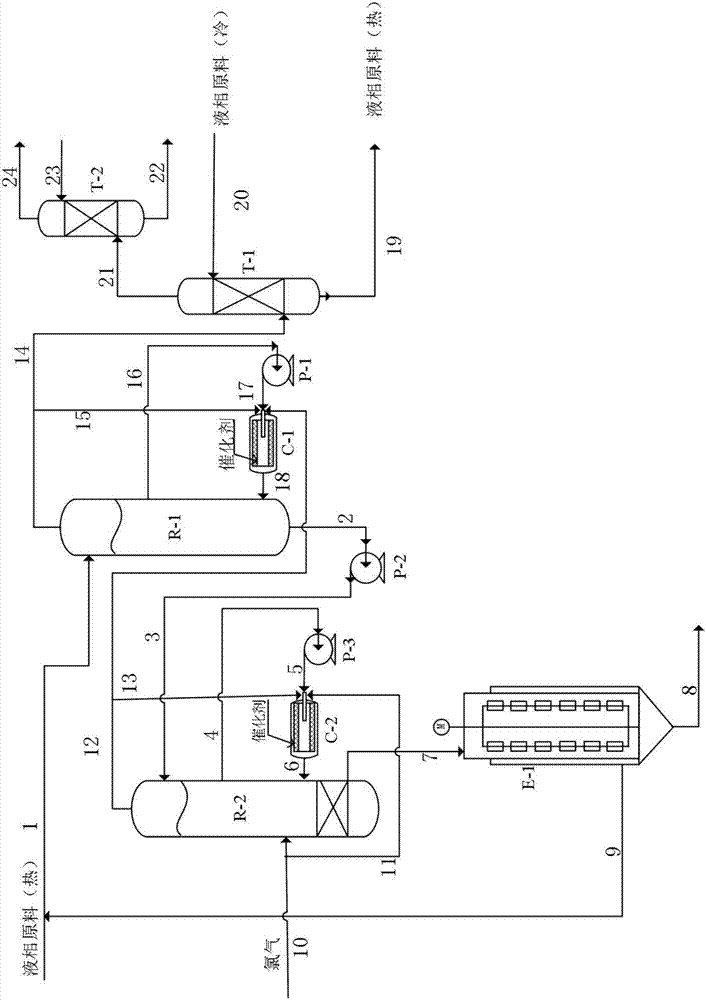Process and device for producing tetrachloro-2-cyanopyridine with liquid chromatography
A cyanopyridine and a production process technology are applied in the field of liquid-phase chlorination reaction processes and devices to achieve the effects of low energy consumption, improved safety and operability, and reduced processing load
- Summary
- Abstract
- Description
- Claims
- Application Information
AI Technical Summary
Problems solved by technology
Method used
Image
Examples
Embodiment 1
[0037] Fill 20kg of FeCl loaded with 5% (wt) in the first microbubble generator (C-1) and the second microbubble generator (C-2) respectively 3Activated carbon was used as a pre-reaction catalyst and a main reaction catalyst. After the liquid 2-cyanopyridine is preheated to 30°C, it enters the first gas-liquid enhanced reaction tower (R-1) at a rate of 125kg / h through pipeline 1 to fully mix with chlorine gas, and the gas-liquid mixture passes through pipeline 16 and the first cycle The pump (P-1) enters the first microbubble generator (C-1), and the pre-reaction is carried out in the first microbubble generator (C-1), and part of the gas phase material can also enter the first microbubble generator through the pipeline 15 The device (C-1) completes the circulation of the gas phase material. The material from the first microbubble generator (C-1) enters the first gas-liquid intensified reaction tower (R-1) through pipeline 18 and fully mixes with chlorine gas. The first gas-...
Embodiment 2
[0039] In the first microbubble generator (C-1) and the second microbubble generator (C-2), respectively fill 18 kg with 5% (wt) FeCl 3 Activated carbon was used as a pre-reaction catalyst and a main reaction catalyst. After the liquid 2-cyanopyridine is preheated to 70°C, it enters the first gas-liquid enhanced reaction tower (R-1) at a rate of 130kg / h through pipeline 1 to fully mix with chlorine gas, and the gas-liquid mixture passes through pipeline 16 and the first cycle The pump (P-1) enters the first microbubble generator (C-1), and the pre-reaction is carried out in the first microbubble generator (C-1), and part of the gas phase material can also enter the first microbubble generator through the pipeline 15 The device (C-1) completes the circulation of the gas phase material. The material from the first microbubble generator (C-1) enters the first gas-liquid intensified reaction tower (R-1) through pipeline 18 and fully mixes with chlorine gas. The first gas-liquid ...
Embodiment 3
[0041] Fill the first microbubble generator (C-1) and the second microbubble generator (C-2) with 25 kg of FeCl loaded with 5% (wt) 3 Activated carbon was used as a pre-reaction catalyst and a main reaction catalyst. After the liquid 2-cyanopyridine is preheated to 110°C, it enters the first gas-liquid enhanced reaction tower (R-1) at a rate of 130kg / h through pipeline 1 to fully mix with chlorine gas, and the gas-liquid mixture passes through pipeline 16 and the first cycle The pump (P-1) enters the first microbubble generator (C-1), and the pre-reaction is carried out in the first microbubble generator (C-1), and part of the gas phase material can also enter the first microbubble generator through the pipeline 15 The device (C-1) completes the circulation of the gas phase material. The material from the first microbubble generator (C-1) is fully mixed with chlorine gas through the first gas-liquid enhanced reaction tower (R-1) in pipeline 18. The first gas-liquid enhanced ...
PUM
 Login to View More
Login to View More Abstract
Description
Claims
Application Information
 Login to View More
Login to View More - R&D
- Intellectual Property
- Life Sciences
- Materials
- Tech Scout
- Unparalleled Data Quality
- Higher Quality Content
- 60% Fewer Hallucinations
Browse by: Latest US Patents, China's latest patents, Technical Efficacy Thesaurus, Application Domain, Technology Topic, Popular Technical Reports.
© 2025 PatSnap. All rights reserved.Legal|Privacy policy|Modern Slavery Act Transparency Statement|Sitemap|About US| Contact US: help@patsnap.com

